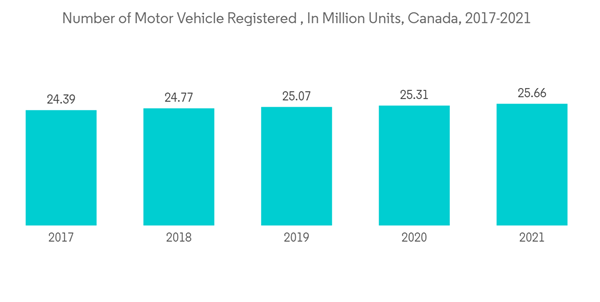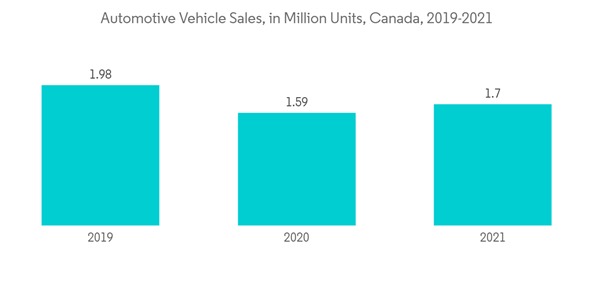The COVID-19 outbreak in 2020 and the first half of 2021 significantly affected the industrial and automotive sectors, caused major production disruptions, and negatively affected customers' purchasing power in Canada, limiting the growth of the Canadian lubricants market. However, the sector is recovering well since these restrictions were lifted. In 2021, annual automotive sales in the country reached 1.70 million units, registering a y-o-y increase of 7%.
Key Highlights
- Over the medium term, major factor like the growing sales of motor vehicles in the country is expected to drive the demand for lubricants.
- Conversely, lubricating oil risks will likely hinder the market's growth.
- The growing demand for biodegradable lubricants may create lucrative opportunities for market growth.
- The automotive segment dominated the market in the country and is also likely to witness the highest CAGR during the forecast period.
Canada Lubricants Market Trends
Engine Oil to Dominate the Market
- Engine oil is the leading product type owing to its high volume requirements and low drain interval, as it is used for high-temperature and high-pressure applications. It is often known as motor oil and is made to lubricate internal combustion engine parts, as well as to shield them from corrosion and keep them cool while operating.
- Engine oil is composed of two major components: base stock and additives. Typically, 95% of the solution comprises base stock derived from petroleum, synthetic chemicals, or a combination. The base stock is in charge of dissipating accumulated heat and lubricating the moving elements of an engine.
- The additives, on the other hand, make up around 5% of the oil, and these compounds are in charge of precisely regulating the oil's lubricity and viscosity and shielding engine parts from wear. For instance, Zinc dialkyl dithiophosphate (ZDDP) is a commonly used additive for preventing wear, while magnesium sulphonates aid in the breakdown of pollutants and engine sludge.
- Engine oils find applications in various end-user industries, including automotive, power generation, heavy-duty equipment, and other industries. There are typically three types of engine oil such as mineral oil, semi-synthetic oil, and full synthetic oil.
- The automotive industry highly consumes engine oil. In Canada, the engine oil demand is mostly supported by the servicing requirements of the current on-road passengers and commercial vehicles. The primary cause of the highest engine oil consumption was the widespread use of class 7 and class 8 trucks, which have diesel engines with high lubricant consumption requirements.
- Furthermore, according to Statista Canada, the total number of road motor vehicles (gasoline and diesel fuel type) registered in Canada increased to 25.6 million in 2021, up 1.4% compared with 2020. With the increased number of gasoline and diesel road vehicle registration in the country, engine oil consumption also increases.
- With the increasing demand from various sectors in the country, engine oil consumption is expected to boost during the forecast period.
Automotive Industry to Dominate the Market
- In the automotive sector, various lubricants, such as engine oil, transmission oil, hydraulic oil, greases, and other lubricants, are used in commercial vehicles and motorcycles.
- Engine oils keep the engine clean and rust-free, improve fuel efficiency and performance, enhance its life, and reduce vehicle emissions.
- Canada is North America's second-largest automotive market. Most international automakers have operations in Canada, such as Ford, General Motors, Stellantis (previously FCA), Toyota, and Honda, which have local assembly lines.
- According to the international trade administration, the industry estimated that the annual retail value of the automobile aftermarket was over USD 19 billion and was largely stable in 2021.
- According to Statistics Canada, during the first 11 months of 2022, the new motor vehicle sales in the country were 1.4 million units. Moreover, according to OICA, in 2021, automotive sales recorded over 1.7 million units, an increase of 7% compared to 2020.
- In the automotive industry, commercial vehicles were the leading vehicle type. In 2021, about 1.38 million units of commercial vehicles were sold in the country, recording a growth rate of about 9% compared to 2020. The high usage of trucks was the key reason for selling commercial vehicles in the country.
- Thus, the factors above are expected to impact the automotive industry, which, in turn, may affect the growth of the lubricant demand in the country.
Canada Lubricants Industry Overview
The lubricants market in Canada is partially consolidated in nature. Some of the major players in the market include (not in a particular manner) BP PLC (Castrol), Exxon Mobil Corporation, HF Sinclair Corporation (Petro‑Canada lubricants), Shell Plc, and Valvoline Inc (Saudi Arabian Oil Co.)Additional Benefits:
- The market estimate (ME) sheet in Excel format
- 3 months of analyst support
This product will be delivered within 2 business days.
Table of Contents
1 INTRODUCTION1.1 Study Assumptions
1.2 Scope of the Study
2 RESEARCH METHODOLOGY
3 EXECUTIVE SUMMARY
4 MARKET DYNAMICS
4.1 Drivers
4.1.1 Growing Sales of Motor Vehicles
4.1.2 Increasing Demand from Manufacturing Industry
4.2 Restraints
4.2.1 Risks Associated with Lubricating Oils
4.2.2 Other Restraints
4.3 Industry Value Chain Analysis
4.4 Porter's Five Forces Analysis
4.4.1 Bargaining Power of Suppliers
4.4.2 Bargaining Power of Consumers
4.4.3 Threat of New Entrants
4.4.4 Threat of Substitute Products
4.4.5 Degree of Competition
5 MARKET SEGMENTATION (Market Size by Volume)
5.1 Product Type
5.1.1 Engine Oil
5.1.2 Greases
5.1.3 Hydraulic Fluids
5.1.4 Transmission & Gear Oil
5.1.5 Metalworking Fluids
5.1.6 Other Product Types
5.2 End-user Industry
5.2.1 Automotive
5.2.2 Heavy Equipment
5.2.3 Metallurgy and Metalworking
5.2.4 Power Generation
5.2.5 Other End-user Industries
6 COMPETITIVE LANDSCAPE
6.1 Mergers and Acquisitions, Joint Ventures, Collaborations, and Agreements
6.2 Market Share(%)**/Ranking Analysis
6.3 Strategies Adopted by Leading Players
6.4 Company Profiles
6.4.1 BP PLC (Castrol)
6.4.2 Boss Lubricants
6.4.3 BP PLC (Castrol) Chevron Corporation
6.4.4 Exxon Mobil Corporation
6.4.5 FUCHS
6.4.6 HF Sinclair Corporation (Petro‑Canada lubricants)
6.4.7 Phillips 66 Company
6.4.8 Shell plc
6.4.9 TotalEnergies SE
6.4.10 Valvoline Inc (Saudi Arabian Oil Co.)
7 MARKET OPPORTUNITIES AND FUTURE TRENDS
7.1 Growing Demand for Biodegradable Lubricants
Companies Mentioned (Partial List)
A selection of companies mentioned in this report includes, but is not limited to:
- BP PLC (Castrol)
- Boss Lubricants
- BP PLC (Castrol) Chevron Corporation
- Exxon Mobil Corporation
- FUCHS
- HF Sinclair Corporation (Petro‑Canada lubricants)
- Phillips 66 Company
- Shell plc
- TotalEnergies SE
- Valvoline Inc (Saudi Arabian Oil Co.)










